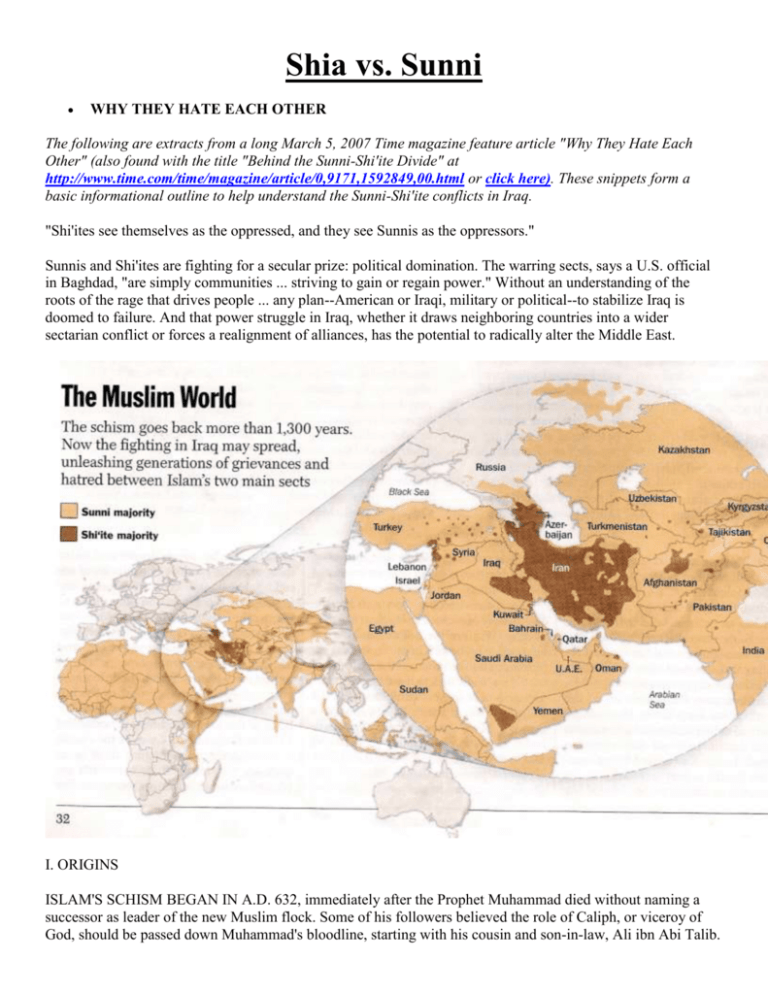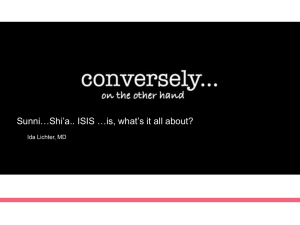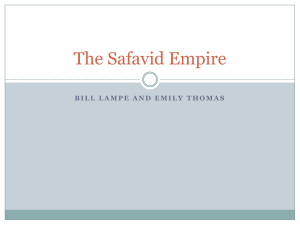
Shia vs. Sunni
WHY THEY HATE EACH OTHER
The following are extracts from a long March 5, 2007 Time magazine feature article "Why They Hate Each
Other" (also found with the title "Behind the Sunni-Shi'ite Divide" at
http://www.time.com/time/magazine/article/0,9171,1592849,00.html or click here). These snippets form a
basic informational outline to help understand the Sunni-Shi'ite conflicts in Iraq.
"Shi'ites see themselves as the oppressed, and they see Sunnis as the oppressors."
Sunnis and Shi'ites are fighting for a secular prize: political domination. The warring sects, says a U.S. official
in Baghdad, "are simply communities ... striving to gain or regain power." Without an understanding of the
roots of the rage that drives people ... any plan--American or Iraqi, military or political--to stabilize Iraq is
doomed to failure. And that power struggle in Iraq, whether it draws neighboring countries into a wider
sectarian conflict or forces a realignment of alliances, has the potential to radically alter the Middle East.
I. ORIGINS
ISLAM'S SCHISM BEGAN IN A.D. 632, immediately after the Prophet Muhammad died without naming a
successor as leader of the new Muslim flock. Some of his followers believed the role of Caliph, or viceroy of
God, should be passed down Muhammad's bloodline, starting with his cousin and son-in-law, Ali ibn Abi Talib.
But the majority backed the Prophet's friend Abu Bakr, who duly became Caliph. [The following paragraphs
relate a complicated series of maneuvers by the opposing sides that eventually led to the establishment of the
two major Islamic sects of Sunni and Shi'ites.]
Today about 90% of Muslims worldwide are Sunnis.
Crucially, Shi'ites outnumber Sunnis in the Middle East's major oil-producing regions--not only Iran and Iraq
but also eastern Saudi Arabia. But outside Iran, Sunnis have historically had a lock on political power, even
where Shi'ites have the numerical advantage. ... Sunni rulers maintained their monopoly on power by excluding
Shi'ites from the military and bureaucracy; for much of Islamic history, a ruling Sunni élite treated Shi'ites as an
underclass, limited to manual labor and denied a fair share of state resources.
"For Shi'ites, Sunni rule has been like living under apartheid."
In the settlement after World War I, [the British] handed the newly created states of Iraq and Bahrain,
both with Shi'ite majorities, to Sunni monarchs.
II. SADDAM'S LEGACY
WHEN SADDAM HUSSEIN ASSUMED POWER in Baghdad in 1979, Iraq's Shi'ites had enjoyed a couple of
decades of respite under leaders who allowed them some measure of equality with the Sunnis. Then came
Ayatullah Ruhollah Khomeini's 1979 Islamic revolution in Iran. Fearing a similar uprising in Iraq, Saddam
revived some old repressions and ordered the murder of Iraq's most popular ayatullah, Mohammed Bakr alSadr, uncle of Muqtada. Shi'ites made up a majority of those killed in Iraq's war with Iran, which lasted from
1980 to 1988, but after it ended they were once again shut out of most senior government and military positions.
With the defeat of Saddam's army in the 1991 Gulf War, Shi'ites saw a chance to rise against the dictator. But
they received no protection from the allied forces, and Saddam was able to smash the revolt. By some estimates,
more than 300,000 Shi'ites were killed; many were buried in mass graves. For the rest of his reign, Saddam kept
the Shi'ites firmly under his thumb. Several popular clerics were killed, including Muqtada's father. Saddam
ordered the murder of Sunnis too, but there was a crucial difference. "When Saddam killed a Sunni, it was
personal--because of something that person had done," says author Nasr. "But when it came to killing Shi'ites,
he was indiscriminate. He didn't need a specific reason. Their being Shi'ite was enough."
Remarkably, despite the profound imbalance in political power and the legacy of repression, many individual
Iraqis forged business, social and personal relationships between the sects. In Baghdad and other cities, most
neighborhoods built in the modern era were mixed. n
III. THE IMPLOSION
FOR TWO YEARS AFTER SADDAM'S FALL, ... many Shi'ite extremists, rather than lashing out at Sunnis,
sometimes joined them in the insurgency against the Americans and their allies.
Inter-sect relations, political and personal, began to fray with the approach of Iraq's first post-Saddam election
in January 2005. Sunni parties boycotted the poll, allowing a Shi'ite coalition to sweep to power. With an
assertiveness that at times bordered on arrogance, the Shi'ite-led government inflamed Sunni resentment. An
especially sore point was the mass recruitment into the police and the military of Shi'ite militiamen, some of
whom used the immunity of their uniforms to avenge old grudges against Sunnis. Sunni terrorism groups
stepped up their bombing campaign, which convinced Shi'ites that the former ruling class was never going to
accept its reduced status.
After the first, furious convulsion of violence, the militias began a more systematic campaign of kidnap and
execution. The bodies of their victims, bearing signs of bestial torture, were often tossed into sewers or garbage
dumps. Jihadi groups responded in kind. The U.S. military had passed on most security responsibilities to Iraqi
forces, but they proved unable to halt the killings. Worse, they were frequently accused of joining in the
fighting, usually on the side of the militias. Last fall two U.S.-Iraqi joint security operations failed to stanch the
bloodletting.
Saddam's execution became another flash point. Even Sunnis who had little sympathy for Saddam were
incensed that the government chose to hang him at the hour of morning prayers on one of the most sacred
Muslim holidays (Iraqi Sunnis celebrated the holiday one day before the Shi'ites). The choice seemed to
confirm suspicions that Shi'ite political dominance would be a constant humiliation. "It was their way of telling
us, 'We're in charge now, and you are so weak that even your holy days have no meaning anymore,'" says media
analyst Kadhim al-Mukhdadi. "That morning I gave up hoping that things would get better."
He is not alone in that hopelessness. Sectarian lines have been drawn through mixed neighborhoods. Where
Shi'ites are in the majority, Sunni families have been forced to leave for fear of death. Sunnis have responded
with their own sectarian cleansing. A large portion of the mostly Sunni middle and upper classes has fled the
country.
IV. A WIDER WAR
The wider Muslim world, however, tends to focus on the big picture. Shi'ites are now politically dominant in
Iraq, and Iran is the leading Shi'ite power. So in most Arab capitals, the sectarian war in Iraq is increasingly
blamed on Iran.
V. THE UNBRIDGEABLE CHASM
MOST IRAQIS, CAUGHT UP IN THEIR OWN terrors, have little time for the angst of the wider Islamic
world. Those who can look past the daily horrors see an even more frightening future, in which their children
carry today's hatreds into the next generation. With thousands being killed on either side, the nationalist, secular
slogans that were long taught in Iraq's schools have lost much of their meaning. And children do not get too
many lessons in secularism at home. "When we were kids, my parents taught us that Shi'ites had the wrong idea
about Islam but were just misguided, not bad people," says Ayesha Ubaid, 26, a Sunni doctor's assistant whose
late husband was a Shi'ite. "But now I hear my brothers and sisters-in-law telling their children, 'Those people
killed our uncle and two cousins and stole our ancestral home.'" Her son Mohammed, 8, returned from school
one afternoon and angrily asked, "Why did you marry an infidel?"
With a large supply of luck Bush's "surge" of U.S. troops, may halt the sectarian fighting in Baghdad long
enough for Shi'ites and Sunnis to start mending fences. If all goes according to plan, the Iraqi government will
use the respite from violence to launch a massive economic program that will create jobs and improve civic
services like electricity and water supply. If the government can do that, says veteran Shi'ite politician Abu
Firas al-Saedi, "people won't immediately start hugging each other and become best friends again--but at least if
they are busy working and making money, they will have time to forget the past." In this optimistic view, the
militias won't take their fight from Baghdad to other Iraqi cities, where the U.S. presence is minimal, and any
security gains in Baghdad will quickly spread elsewhere.
It's too early to tell if the new operation will damp down sectarian tensions. [10/07: so far it hasn't worked; too
little progress has occurred.] "There are more ways in which this could go wrong than go right," says political
analyst Tahseen al-Shekhli. "We have seen too many plans fail to have any faith in this one." ... So despite his
professed conviction that the security operation is working, chances remain high that it will eventually falter,
brought down by the inability of Sunnis and Shi'ites to find a political settlement or the reduction of U.S.
forces that is bound to happen one day.
And then all hell would be let loose. Iraq is a country where almost every household has at least one AK47. If there is no Sunni-Shi'ite rapprochement, a full-blown civil war would raise the daily death toll from
the scores to the hundreds--to say nothing of the escalation that would come if neighboring countries
became involved, Iran backing the Shi'ite militias, Arab states sponsoring the Sunnis. Such a war could
continue for years, with each sectarian community splitting into smaller factions led by rival warlords. In
Baghdad, the ethnic cleansing would continue to its logical conclusion, with the city split into a Shi'ite
east and a Sunni west.
Iraq's Sunnis and Shi'ites may now be contemplating a future that they cannot share. There could be no more
bitter legacy of the Bush Administration's fateful decision to go to war in Iraq.
Copyright 2007 Time Inc. All rights reserved.










